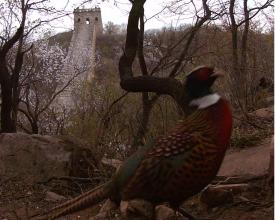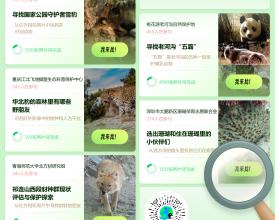
Adam's Wildlife Friends
There should be over one million infrared cameras utilized around the world, capturing hundreds of millions of images of wildlife, almost all of which are applied to scientific research. Adam’s Wildlife Friends has shared infrared photos previously undisclosed to the public, allowing them to meet wildlife friends unseen face to face, experience the magnificence of nature.
Wildlife Friends is a mini program. It is China’s largest intelligent management system for wildlife photos captured by infrared cameras at present. Wildlife Friends is driven by WeChat (a social media) jointly established by Adam and Tencent Tech Philanthropy.
Adam is a 16-year-old teenager born and bred in Beijing. He is the most influential wildlife protector among Chinese teenagers and the Chief Volunteer of Tencent Tech Philanthropy. He shoots wild animals at the foot of the Great Wall situated in the suburbs of Beijing all year round and posts his photographic works on Wildlife Friends.
Tech4Nature Award
Wildlife Friends is a mini program, with a QR code available at the entrance of the Great Wall in Beijing, which notifies tourists that here live some unseen wild animals and you may scan the QR code to watch the videos where they wander on the deserted Great Wall if you are interested to know what they are. This mini program will be seen in increasingly more wildlife forest parks in China.
Wildlife Friends developed by Adam is supported by the largest social media in China – “WeChat”, which attracts approximately 1.3 billion users. WeChat Mini Program is an interactive application accessible without download, and Wildlife Friends, through automatic identification of geographic location, displays the photos captured by infrared cameras of various wild animals “invisible” in our daily life. This technology is most distinctly characterized by simplicity and convenience for tourists, with the currently leading AI recognition system for wildlife species, “Species Eye”, and a super-large database accommodating 1 billion photos operated in its backstage. All those photos are taken at national parks, nature reserves, public welfare institutions, and universities in China, and were once used only for private academic research without disclosure to the society and individuals. Up to now, Wildlife Friends has uploaded 200 thousands photos of wildlife from five institutions such as Chinese Felid Conservation Alliance (CFCA), Shan Shui Conservation Center, and the Paradise International Foundation.
At the backstage of Wildlife Friends is a powerful AI recognition model called “Species Eye”, which is capable of identifying 286 native Chinese mammals and poultry in China, including animals under first-grade state protection such as snow leopard and Tibetan antelope, as well as numerous species under second-grade protection. For 66 types of species with rich data, the accuracy of recognition can reach 85% on average, and that of panda, takin, and forest musk deer even come up to 94%, 90%, and 90% respectively. Species Eye can swiftly identify 20,000 photos in one hour and is designed to cover over 1,500 birds in China by end of this year.
The cooperation between Adam and Tencent Tech Philanthropy underlies the emergence of Wildlife Friends and provides the access for citizens to the vast number of photos of wildlife captured by infrared cameras piled up in disks for the first time. In addition, the public can also get acquainted with “friends in the wilderness never met before”. Wildlife Friends will gradually serve as the “ecological map” of China, able to evaluate the biological diversity of every city and region.
Context
Challenges addressed
The first challenge is posed from organizations and institutions which own wildlife photos captured by infrared cameras now. There are a great many such entities in China, most of which are state-owned, and some are even confidential, especially national parks and nature reserves. It is question whether those wildlife photos they shot can be provided to Wildlife Friends.
The second is the processing capability of massive photos. It is the most troublesome problem to many frontline protectors to handle perhaps hundreds of thousands of photos captured by infrared cameras from an organization in wildlife protection and monitoring. Individual wildlife recognition is even a manual labor requiring technical expertise.
The third is forest parks and nature reserves. The simplest method for forest parks to protect wild animals is merely protecting them without being opened to the public, which, however, deviates from its objective of establishment to introduce the beauty of nature to the public.
Location
Process
Summary of the process
Citizens’ participation is challenging. Wildlife habitats are far from the downtown. Unlike cats and dogs, they lack the “loveable elements” in appearance, rendering it difficult for the public to establish an attachment with them, which reduces the degree of participation in donation and protection. It is necessary to use technical means to lower the threshold for participation and transform protection into accessible daily behaviors. Wildlife Friends is supported by the largest social media in China – “WeChat”, which attracts approximately 1.3 billion users. WeChat Mini Program is an interactive application accessible without download, and Wildlife Friends, through automatic identification of geographic location, displays the photos captured by infrared cameras of various wild animals “invisible” in our daily life. This technology is most distinctly characterized by simplicity and convenience for tourists, with the currently leading AI recognition system for wildlife species, “Species Eye”, and a super-large database accommodating 1 billion photos operated in its backstage.
Building Blocks
WeChat Mini Program Development
WeChat Mini Program is an application accessible without download, near at your fingertips just by scanning or searching. It is very simple to design a mini program, as a mini program development environment and developer ecosystem has been established in nearly two years. WeChat Mini Program is also an innovative achievement which genuinely influences general programmers in China’s IT industry for it involves over 1.5 million developers in its development together with WeChat. Its number has exceeded 1 million, encompassing more than 200 subdivided sectors and accommodating 200 million daily-active users.
1. Use without download: Users can open the mini program by scanning the QR code or searching in no need of download, which saves the storage space for mobile devices and lowers the usage threshold; they can quickly visit the mini program directly through WeChat to meet their temporary usage demands.
2. Low development costs and short cycle: The mini program sets a low technical standard and causes a small learning cost to developers based on front-end technology stacks (HTML/CSS/JS); and is compatible among various platforms and supports iOS and Android after development, which saves human labor and time costs.
3. Powerful traffic inlet and social fission: WeChat boasts 1.3 billion monthly-active users so it is easy to cultivate a sound user base. It supports the sharing channels to chat boxes, Moments, official accounts, and Search. Social dissemination, through sharing, group buying, and bargaining, can rapidly multiply and is suitable for marketing activities.
Enabling factors
Wildlife Friends is a mini program on WeChat. As a lightweight application, it boasts the following apparent advantages suitable for quick access for users and enhancement of their use experience: Use without download: Users can open the mini program by scanning the QR code or searching in no need of download, which saves the storage space for mobile devices and lowers the usage threshold; they can quickly visit the mini program directly through WeChat to meet their temporary usage demands.
Processing of Numerous Infrared Images Driven by AI Species Recognition
The Mini Program, with AI intelligent recognition as the underlying technology and endangered species as the core targets for recognition, trains a large biodiversity recognition model capable of monitoring such systems as mountains, rivers, forests, fields, lakes, grasslands and sandy lands. This recognition model features a powerful “engine” – Species Eye. As the fundamental and general model of “Wildlife Friends”, it is primarily characterized by strong learning capability, that is, multimodal recognition based on no or a few samples. It indicates that it can rapidly recognize the location and species information of multiple wild animals based on a few samples. For instance, it may take thousands of photos to be captured and days’ training for a traditional model to recognize a new species, but Species Eye can complete such mission quickly through a small number of photos, as well as trainings and iterations. In addition, it boasts a high extent of tolerance. It is no longer limited to the training and prediction for specific species with a powerful capability of open vocabulary identification and zero-sample recognition, and is able to accurately recognize and locate species without trained data. For instance, traditional models can merely recognize species based on trained data, such as tiger and antelope; while this new model can discriminate snow leopard and fox at the same time even without trained data of those two wild animals before. Another advantage of “Species Eye” is lower costs. Common AI models rely heavily on high-performance accelerator cards, which cause a high cost in hardware environment and its maintenance.
Enabling factors
The underlying technology of this mini program is advanced and complex. Firstly, it has a powerful storage function that can store over 100 million infrared camera-taken photos provided by social institutions.
Connection with Citizens
Interactive Interface for Citizen Scientists
Apart from common comprehension of wildlife, citizens can also get involved in the following advanced activities and become “citizen scientists”.
1. Verify the existence of wild animals through the AI recognition tool “Species Eye”;
2. Estimate the number of wild animals manually;
3. Select the species of wild animal;
4. Figure out the name of the wild animal through the AI recognition tool “Species Eye”;
5. Ensure the accuracy and consistency of data by marking the geographic location.
Impacts
At present, around 100,000 infrared cameras have been installed in China’s nature reserves, as well as government authorities at all levels, nature reserve managers, non-governmental organizations (NGOs), higher education institutions, and research institutes. Those infrared photos of wildlife were not shared and disclosed to the public, let alone individuals. Wildlife Friends, however, is a mini program featuring pure openness to the society, tapping into the social values of those infrared photos to a maximum extent.
China’s nature reserves were involved in a contradiction: On the one hand, the public is not allowed to explore in such areas, especially to avoid disturbing protected wild animals. On the flip hand, natural reserves ought to play the role of popular science education for the society, introducing to citizens flora and fauna therein and corresponding protective measures. Wildlife Friends abridges the gap in practical tools before and can defuse this contradiction by balancing the aforementioned two aspects well.
To citizens, it is also a great harvest to view some objects invisible in regular days in the simplest way when visiting a forest park. It is also fruitful to, by walking on the ancient Great Wall in Beijing and scanning a QR code board there, encounter such surprise that roe deer and gorals will also wander on the Great Wall when there are few tourists.
Beneficiaries
Chinese Felid Conservation Alliance (CFCA), Taohuayuan Ecological Protection Foundation, Shanshui Nature Reserve Center, Shenzhen Dapeng New Area Coral Conservation Volunteer Federation
Additionally, explain the scalability potential of your Solution. Can it be replicated or expanded to other regions or ecosystem?
The cooperation between Adam and Tencent Tech Philanthropy underlies the emergence of Wildlife Friends and provides the access for citizens to the vast number of photos of wildlife captured by infrared cameras piled up in disks for the first time. In addition, the public can also get acquainted with “friends in the wilderness never met before”. Wildlife Friends will gradually serve as the “ecological map” of China, able to evaluate the biological diversity of every city and region. There should be at least one million infrared cameras utilized around the world, capturing hundreds of millions of images of wildlife. As long as there is social media, it is easy to build software like Wildlife Friends. As long as there are volunteers like Adam, it is easy to allow the public to meet wildlife friends unseen face to face, experience the magnificence of nature, and coexist with wild animals on the same planet.
Global Biodiversity Framework (GBF)
Sustainable Development Goals
Story

Sixteen-year-old teenager Adam, who is born and bred in Beijing, has always hoped to capture an infrared photo of wild animal with the Great Wall as the background. In recent years, due to the improvement of the ecological environment in Beijing, large wild animals such as roe deer, gorals, leopard cats, and foxes, which had been invisible in the northern mountains for many years, have begun to reappear. However, the most precious native species, North China leopard, is still nowhere to be found. Before the 1980s, North China leopard was always found in the deep mountains of the Taihang ranges in Beijing.
When Adam was nine years old, he became the youngest volunteer of Chinese Felid Conservation Alliance (CFCA). The volunteers have been searching for the traces of North China leopard in the Taihang Mountains. In 2016, CFCA identified about 40 adult leopards in the nature reserve in Shanxi Province, which is the known closest habitat of North China leopard to Beijing, about 400 kilometers away. In Jul. 2020, Adam and CFCA discovered the traces of North China leopard in the nature reserve of Tuoliang Mountain, Hebei Province, which is about 300 kilometers away from Beijing. This news was released at COP15 held in China the following year. Adam was hailed by the media as the “Chinese Juvenile Leopard Seeker”. Currently, many volunteers of CFCA are still searching for North China leopard in the mountains closer to Beijing.
They have a great vision of bringing North China leopard back to Beijing, which is a project called “Bring the Leopard Home” Program. It does not mean airlifting leopards into the mountains of Beijing, but rather assessing the food chain, evaluating the continuity of the ecological corridor, and eliminating human hunting activities, allowing the North China leopard population in Shanxi and Hebei to naturally extend to their original habitat.
From 400 kilometers to 300 kilometers and then 200 kilometers, it seems that the footsteps of North China leopard returning to Beijing are approaching. However, unfortunately, in the mountains around Beijing, North China leopard has not been found in the past six years. Despite disappointment among Adam and other volunteers, through their infrared photos and Wildlife Friends, Beijing citizens have learned about this animal and got acquainted with more and more wild animals reappearing around Beijing. Perhaps North China leopard will also come back in the coming time.










